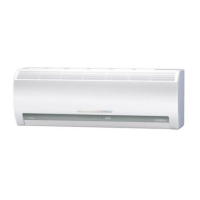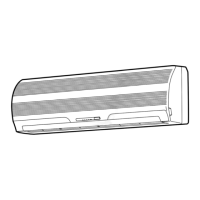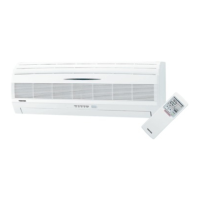
Do you have a question about the Toshiba RAS-24UFHP-ES and is the answer not in the manual?
| Brand | Toshiba |
|---|---|
| Model | RAS-24UFHP-ES |
| Category | Air Conditioner |
| Language | English |
Covers critical dangers, installation warnings, and operational risks.
Addresses cautions for operation, movement, and repair safety.
Details safety requirements for unit installation and operational safety.
Identifies parts of the outdoor and indoor units.
Explains the indoor unit's display panel and temporary operation button.
Describes fundamental remote control buttons for operation.
Details advanced functions like Hi POWER, timers, and memory.
Lists and explains various indicators shown on the remote display.
Guides on inserting batteries and their proper maintenance.
Provides steps for setting and adjusting the remote control clock.
Outlines the procedure for installing air filters.
Highlights essential precautions for using the remote control.
Advises on optimal remote control placement and holder installation.
Explains how the air conditioner automatically selects modes based on temperature.
Details standard modes: Cooling, Heating, and Fan Only operation.
Describes the specific settings and operation of Dry mode.
Covers Hi POWER mode for rapid cooling/heating and timer setup procedures.
Explains setting and cancelling combined ON and OFF timers, including daily settings.
Guides on memorizing and recalling frequently used operational settings.
Details how to adjust vertical and horizontal air flow direction.
Explains how to enable, use, and disable the auto restart feature.
Describes the logic behind Automatic, Hi POWER, and ECO operations.
Covers Dry mode operation and provides tips for economical use.
Explains temporary operation and the air filter reset indicator.
Outlines unit/remote cleaning, pre-operation checks, and storage preparation.
Details the process for cleaning the air filters.
Provides specific care instructions for Zeolite and Purifying filters.
Explains operational features like protection, heating, and power failure.
Lists temperature and humidity limits for optimal air conditioner performance.
Addresses critical faults requiring dealer contact and initial checks.
Lists common causes for performance issues and unit inoperability.
Describes common phenomena that are not considered unit failures.
Presents detailed technical specifications for the air conditioner.
Troubleshoots issues related to the remote control display and signal reception.










